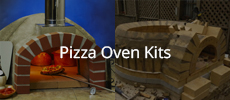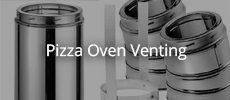Continued with the thermal break by putting 2 layers of 18mm rope into the space that I left between the arches I will then fill the back with vermecrete
I then mounted the flue riser and temporary sat the flue pipes and wind cowell on so I could start curing, before the curing I put on 4 layers of blanket on the barrel
I started at 7.30am using heat beads and held the temp under 140c until midnight so it had a good 16 hours or so of constant heat
Announcement
Collapse
No announcement yet.
Karangi Dudes Barrel Bread Oven
Collapse
X
-
The stainless “thermal break” will look good, but I doubt it will be affective, as shown, because of the high conductivity of the stainless.
The thermal conductivity of 304 stainless is around 10 x that of firebrick. The thickness of the stainless tube that I’m guessing is around 1.2 mm would make the volume of steel around 1/10 th that of the volume of solid brick. So, 1/10 x 10 = 1 which theoretically is the same outcome.
Because the tube is not flexible it cannot act as an expansion joint, which is a far more important feature IMO..
An inverted U shape, ie the bottom missing and filled with CFB, in 0.55 mm stainless would reduce the volume of the stainless by more than 60% as well as providing sufficient spring to act as an expansion joint.
An alternative is to cut a 45 degree angle off the bottom of the mating bricks so they touch at the top but leave a much wider gap at the bottom therby reducing conduction at mating surfaces.Last edited by david s; 05-21-2019, 02:20 AM.
Leave a comment:
-
Before laying the entry bricks I poured a layer of vermecrete to bring it up to height, to make a thermal break I used a 50mm thin walled stainless tube filled with blanket and cut a piece of fibre board to sit it on
I then laid the entry bricks up level with the stainless tube, there will be a decorative arch to go out front at a later date6 Photos
- Likes 1
Leave a comment:
-
I had to do some fancy cutting so the bricks at the top of the flue arch would be level for the flue pipe riser that is a two skin stainless (8'' and 10'') 200mm and 250mm
I decided to go 50mm higher so I cut a 200mm hole in a 300mm x 300mm x 50mm tile (now that was a bit different) it took some doing but it is now nice and level
The flue pipe opening from inside the arch to the top of the 50mm paver tapers from about 10'' at the bottom of the arch bricks to 8'' where the riser will sit.
I mortared them in place and pointed up the inside of the flue arch6 PhotosLast edited by Karangi Dude; 05-15-2019, 04:47 PM.
Leave a comment:
-
I cut the 2 corner bricks of the flue arch laid them then filled the sides with vermecrete for more buttress
I finishes making the form for the flue arch, I then set it in place and cut the flue arch bricks and got them laid5 Photos
Leave a comment:
-
Set out and laid the sides of the flue arch leaving a thermal break of about 12 mm, I then welded the folded steel sides for buttress and filled them with vermecrete5 Photos
Leave a comment:
-
Funny Mike, I was singing that same song as I was going in and out cleaning up the entry (those were the days)
Well, you don't know what we can find
Why don't you come with me little girl
On a magic carpet rideLast edited by Karangi Dude; 04-30-2019, 02:36 AM.
Leave a comment:
-
I have to say that my mind immediately started playing Steppenwolf's 1968 classic Magic Carpet Ride when I saw your entry pic! Thanks for not only doing the documentation on this fabulous build, but for bringing me back a great music memory!
Leave a comment:
-
Coming along nicely. Yes, climbing inside is not pleasant but a rite of passage.......LOL.
Leave a comment:
-
Closed up the oven by putting the last row of bricks above the door arch, I then climbed inside and did some pointing up and cleaning up, that part of building ovens is my least favourite thing3 PhotosLast edited by Karangi Dude; 05-02-2019, 11:48 PM.
Leave a comment:
-
Thanks David,
I have read some of the test results you have done in the past they all make good sense, what I was trying to point out is that there is a lot of water under the hearth that needs to be removed one way or another and that a lot of people don't realise that it is hard to remove
- Likes 1
Leave a comment:
-
Yes, this doesn't surprise me. The vermicrete can only really dry from the top surface when all others are covered. It invariably takes longer than you’d think also when you are judging from the appearance of the top surface which looks really dry. I bet that steel would also get pretty hot standing in the sun, it would be pushing out moisture from the bottom.Originally posted by Karangi Dude View PostThanks Mike,
Interesting observation for those wondering about the time it takes for vermecrete to dry:
I poured the insulation for the front landing 7 weeks ago 7 vermiculite (No3) 1 cement at 30% hydration
I have just taken off the front of the form (boxing) and you can see clearly that there is still a lot of moisture in the vermecrete, It has been baking in the sun at 40c plus for most of the seven weeks
This is just inside the form work so imagine how wet it is under the hearth, luckily I have drilled weep holes under the base to allow the excess moisture to escape when I start to heat the oven up
You may be interested in an experiment I did a number of years ago (attached).
I have just done some more tests on some different insulating materials (calsil board, 5;1 vermicrete, 10;1 vermicrete, pumice, IFB, loose perlite) to record both absorbency and drying rates, but I'm currently battling with Excel and graphs to get it into a decent readable form. I will post it when done.
Vermicrete insulating slab copy.doc.zipAttached FilesLast edited by david s; 04-26-2019, 11:29 PM.
Leave a comment:
-
Thanks Mike,
Interesting observation for those wondering about the time it takes for vermecrete to dry:
I poured the insulation for the front landing 7 weeks ago 7 vermiculite (No3) 1 cement at 30% hydration
I have just taken off the front of the form (boxing) and you can see clearly that there is still a lot of moisture in the vermecrete, It has been baking in the sun at 40c plus for most of the seven weeks
This is just inside the form work so imagine how wet it is under the hearth, luckily I have drilled weep holes under the base to allow the excess moisture to escape when I start to heat the oven up3 Photos
Leave a comment:
-
Yes, I do love the upper transition "curve". If you have a smooth flow, you don't have cool spots (ledges/edges) that collect creosote. The flow for my oven out is pretty good, however I have a straight wall and top ledge immediately above the oven opening (into the smoke funnel). I do get buildup there and when I open either my fire door or working door, the pulse of heated air rising up the flue will often cause a brief soot/creosote "snow fall" onto the landing . So I always include a little pause between changes to "flow up the chimney" and bringing any food items out onto my landing.
. So I always include a little pause between changes to "flow up the chimney" and bringing any food items out onto my landing.
You oven's looking spectacular!Last edited by SableSprings; 04-23-2019, 09:58 AM.
Leave a comment:





Leave a comment: